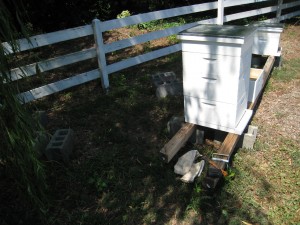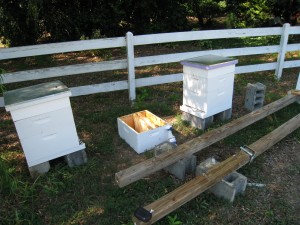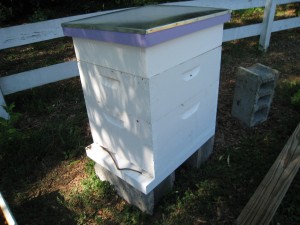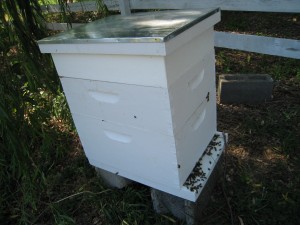We have passed the mid-point of June and two of my stronger hives are clearly not going to produce any honey this year (well, that’s my estimation – here in Richmond, Virginia (although I am in Henrico), the main flow typically ends in June.) This year, with everything starting so much earlier, it seems logical to me that things will peter out a bit sooner then normal. My June Bearing strawberries were finished by the time June came around this year. My strongest hive has done a great job working a medium super, but I am doubtful of getting honey from this one either.
So, how to I make this a positive season? I decided that I would do a couple of splits. I wanted to give my Pop one split and keep one for myself. Since this is my first year with established hives, I also wanted to let one hive play out for the Summer, just to see what it would do. I decided to let the Geronimo Hive play out. I do not intend to mess with it and want to see what it will do. But, I will split both the Albo Hive and the Westover Hive for my two splits this year. Today, I tackled the Westover Hive.
What is a split? It is simply taking one hive and making two out of it. The complex part comes in ‘how to split.’ The ‘how’ means different things to most folks. For my split, it meant dividing the hive in two. Both of my two target hives have two full deeps (for the brood chamber) and one medium that they are working on (my attempt at getting some honey.) I will divide the frames between the two hives, making sure both have at least one frame of eggs and an equal number of brood and other frame types (stored honey, capped brood, larva, pollen, etc…) Then, the hive with the queen will build up, while the hive that does not get the queen will raise their own. Simple. Heh.
When you read or hear about most splits, they are done in the early Spring, just before the main flow. This is the optimal time to do a split and possibly still get a respectable honey harvest. Obviously, I am doing it after the main flow, which probably puts my splits at risk. My plan is to offer them a lot of feed over the next few months and hope that they build up to two deeps again and stock up for the Winter. We’ll see how it goes.

When I arrived at the Westover Hive, all seemed well. Actually, it seemed calm compared to other days. There was no bearding, but a very active landing board, bees coming and going at a rate of 4 or 5 every second. Since I had seen bearding most of the previous week on all of the hives, I went to check out the others to make sure something wasn’t amiss (did they just swarm?!) As it so happens, all of the hives had fairly empty landing boards (the Geronimo Hive was just starting to do a tad of bearding.) So, it was time to do the split.
The tools that I brought with me were my hive tool, a spray bottle of syrup, my frame clamp (for getting the frames out easier), a camera, and a brood chamber (to hold frames while I divided them up with two frames of foundation (in case I had a problem with Small Hive Beetles or otherwise needed to swap out a damaged frame). I placed four cinder blocks behind the parent hive, facing it, to place my two splits on. The scouts would want to come back to the original location. I decided to place both splits a few feet from this location to hopefully keep the populations fairly even.

I then pulled off the top of the parent hive and cracked the inner cover. Immediatly, about a dozen bee fighter jets came up out of the hive to give me the what’s for. This was more aggressive then I was used to and am definitely coming to the conclusion that this hive is my most aggressive hive. No more excuses. Regardless, I went to work.
I have become fairly oblivious to the regular flight of bees, wearing some shorts my veil and some gloves. But, by the time that I had dealt out 5 frames, I regretted that decision. Two bees landed on my knees and gave me a good stinging. In addition, I now had around a hundred bees buzzing me in the air (a hundred is a lot – when they are butting up against your veil to such a degree that you have a hard time seeing if their are eggs in the comb of a frame, you know you have some irritated bees!) After the stings, I retreated to the house for a drink of water and some long pants…
At this point, I may have made a mistake, but I am thinking that it will work out ok. On frame 6, I finally spotted the queen of this hive. I tried to get a picture, but she melded back into masses before I could get the camera focused on her. She was a big one, to be sure, and her wings looked just fine. But, this is where I learned a good lesson. I had already counted out 2 frames of brood and 1 frame of nectar/honey for both hives. On one, I had confirmed eggs. When I found the queen, I should have placed her on the other one. But, I placed her on the brood chamber that already had eggs. In my mind, I figured that I would find another frame of eggs for sure, but such was not the case.

As I went through the frames, I found several that were probably in the 4 to 6 day range, but did not confirm eggs again (I am sure there were eggs on some of these frames, but I did not spot them.) A 4 day old bee has just emerged from the eggs stage but is still viable for a queen (she is still getting royal jelly.) But, there is no guarantee that I placed such a frame in the queenless hive. I could have gone back to find the frame with the eggs, but the bees were really going crazy at this point. When I would remove a frame, a good 50 or so would leap into the air (joining the rest) and start the attack. The cloud of bees around me became thicker then when I did the tree extraction (I really wish I had gotten that queen now…) I have come to the definite conclusion that these bees are almost more aggressive then I would like (notice the word ‘almost’.) I would like to see how they do when they start the year with a full complement of bees (I am wondering if they will out produce the more gentle bees – they sure work hard.) The bottom line is that I am torn between wanting to breed their work ethic with not wanting to breed their aggressiveness. I would hope to get the former, but with my luck, would only get the latter!
Once I got the hives separated, I put a top feeder on both and put a full gallon on each. Up until today, the parent hive had been drinking about a gallon a day (I was feeding them in preparation for this split.) We’ll see how they do as two hives. It should be noted (for humor’s sake) that I received my second sting when putting on the feeders. When I bent down to grab one of the feeders, it must have opened a small hole in the suit, as I suddenly and eye-to-eye with a pissed off bee. An observer would have gotten a chuckle, as I ran across the field, disrobing as I went. This was a mistake, as a good 50 or so bees followed me and one snagged me on the shoulder as I rounded the corner. The one in the suit never did get me and I was able to set her free once back at the house.
Some other things to note:
- I used the bottom board, cover and main brood chamber from the parent hive for the queenless hive
- I put the queen right hive in the top brood chamber of the parent hive
- I divided the partially (hardly) drawn super in half, effectively putting a medium on top of both hives.

At the end of the event, both hives faced one another with an empty deep between them. I placed a small twig in the entrance to both and stepped back to watch (through a mass of angry bees…) The queenless hive had a ton of bees come out on the landing board, but I did not see any of them fanning. Since this was the landing board from the parent hive, maybe it was to be expected. The queen-right hive had 1 bee come out of it while I watched. Otherwise, no activity. I actually had to check to see if I put the bottom board on wrong. But, it was true – no activity there. Finally, I filled up the feeders and got out of dodge. These bees were not happy. I think I smelled to high heaven of alarm pheremone (from my body, but primarily from my suit and gloves – I had seen a dozen sting the suit/gloves). I probably need to wash the thing now.
As to the egg situation with the queenless hive, I am not concerned. If I do not see a queen cell by next Monday, I will drop a frame of eggs from one of my other (more gentle) hives. I am now a bit worried about the frame of eggs that I took from the Westover Hive to queen up the Southside Hive. We’ll see how that queen does (assuming she hatches and mates successfully.)

Reader Comments
Sure wish you’d come to Appomattox and give me a hand with a split. Us first timers are really concerned,confused,and uncertain of the whole process. Would even pay for your time/gas/lunch, etc. Steve
How did this end up working out for you?
Did it work?!
Thanks!
This worked out great, Beamon. The foragers all came back to the queenless hive, which I think helped a lot. The queen-right hive was very quiet for several weeks, with very few bees coming and going. I ended up putting a home made robber screen on them, as it didn’t appear like they had a lot of guard bees (in retrospect, with my current experience, I probably would just drop an entrance reducer on the hive.) Both of these hives came through the Winter strong, although the parent (queen right) hive stronger then the child. The parent tried to swarm in late March, the child in mid-April. I took Nucs off of both hives and have several 1st year queens building strong Nucs or (in a couple of cases) already filling out their first deep. It appears to me that I will pull at least 3 shallows of honey off of the parent hive, but none off of the child hive (this is because I ended up splitting them 3 weeks ago, so the honey build up was drastically reduced as they started working on tons of frames of foundation in the lower deeps.)
All in all, I think splits are great, as long as you do them when the flow is on. In my area (central Virginia), I do not do a split after June 1. You can make it work, but it’s a lot of extra effort trying to stop the robbing and all of that nonsense.